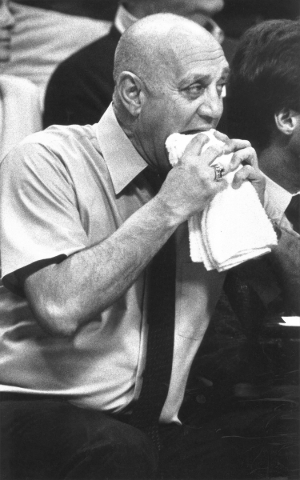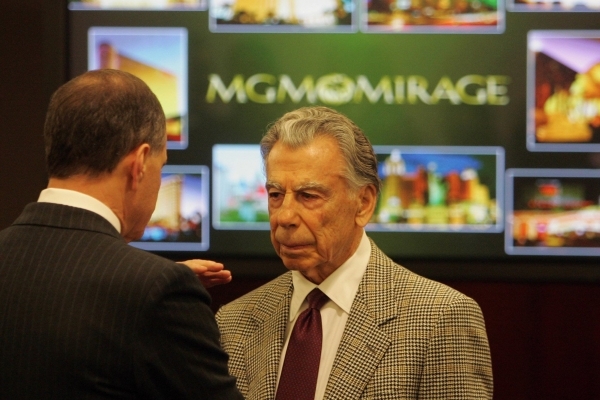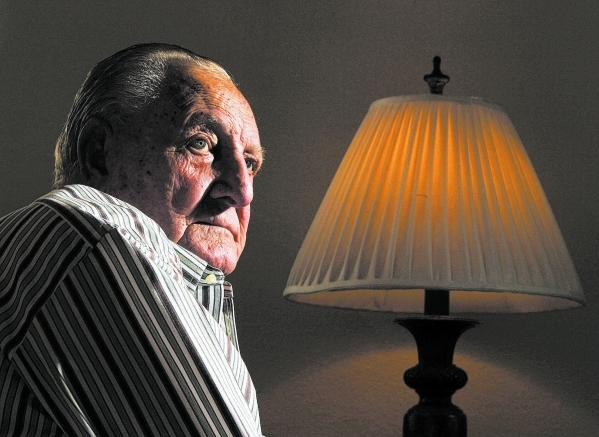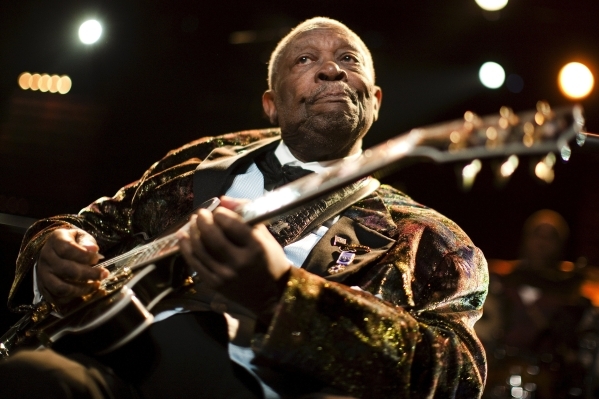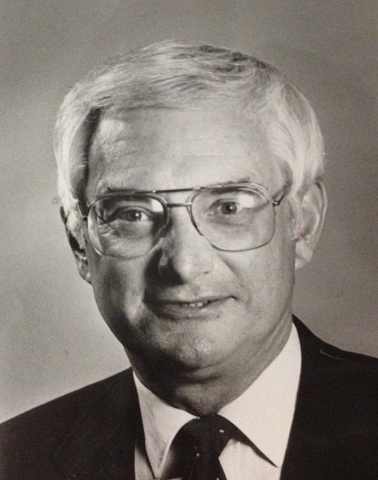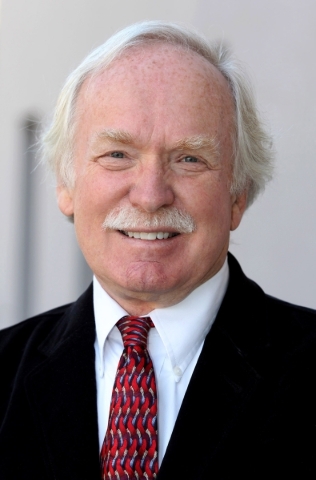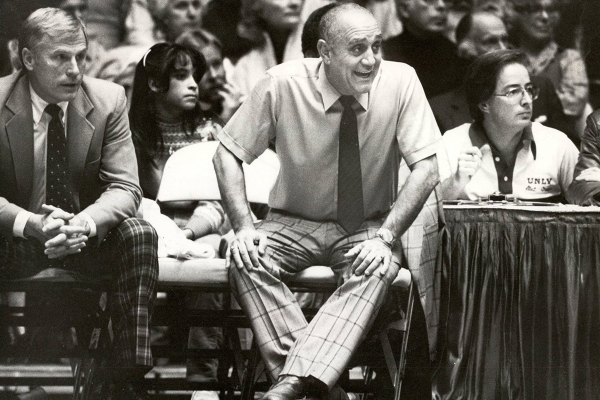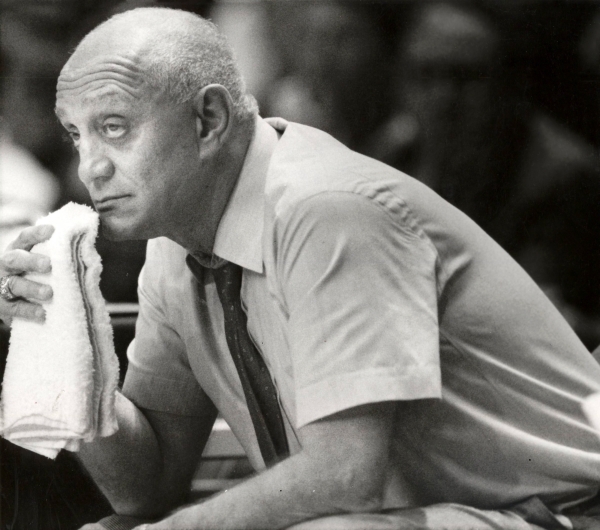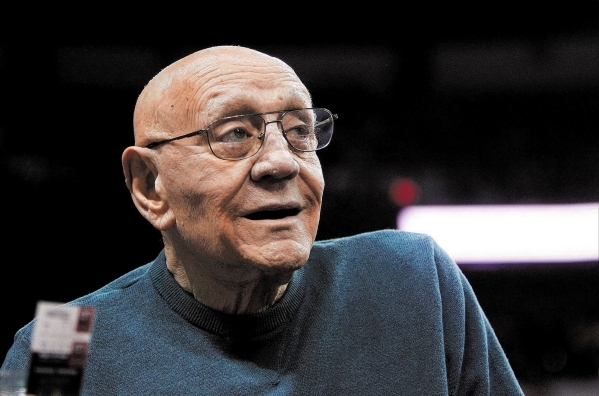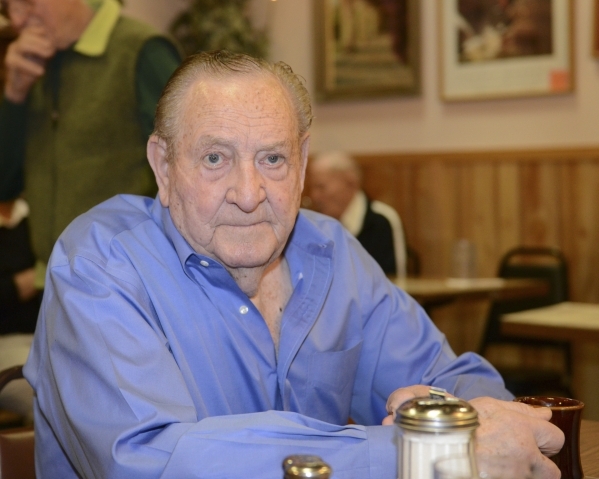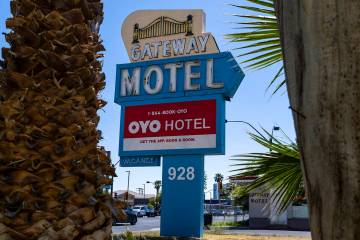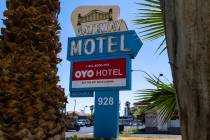Tarkanian, Kerkorian among those who left indelible mark on Las Vegas
Jerry Tarkanian
In the days following his death, Jerry Tarkanian was remembered for his personality, his profound influence on Las Vegas, his incredible impact on UNLV, his unique character, his off-court troubles with the NCAA, his love of pasta and ponies.
Mostly, that he changed basketball forever.
Tarkanian died Feb. 11 at Valley Hospital Medical Center from respiratory and cardiac failure. He was 84, a man who influenced lives well beyond those lights on the Strip that were dimmed in his honor.
"I am not and never will be a Runnin' Rebel," Chris Herren, a former player of Tarkanian at Fresno State, said tearfully at a memorial for the coach at Thomas & Mack Center. "I am not a national champion. My career can't match the legends that played here. But I can say this with pride: that we all share one common bond in that we played for the greatest coach to ever coach this game.
"The name 'Tark the Shark,' will live on forever. But the Tark I knew was gentle, humble, hardworking. He taught me about forgiveness and empathy. He wore his heart on his sleeve and would give you the shirt off his back. He was an amazing dad, a really cool grandpa, and he will always be the most loyal, best friend anyone could have in life."
UNLV honored its Hall of Fame coach and his family in a heartwarming service that brought together a countless number of those touched by Tarkanian throughout his career. He led the Rebels to four Final Fours, including a national championship in 1990.
Over 43 years, Tarkanian made coaching stops at places such as Riverside City College, Pasadena City College, Long Beach State and Fresno State and the San Antonio Spurs.
But no one stood taller and delivered more success in the basketball arena of Las Vegas and UNLV history than Tarkanian, and few have been more responsible for enhancing the city's brand on a national level.
— Ed Graney
Kirk Kerkorian
He was the city's true "Mr. Las Vegas," a billionaire investor who built the Strip's biggest megaresorts and helped usher in the resort corridor's modern era.
When Kirk Kerkorian died in June at 98 after a brief illness, friends and colleagues remembered him as a humble pioneer who accomplished a great deal with little fanfare.
Kerkorian three times built the world's largest hotel-casinos of their day — the International (now the Westgate Las Vegas) in 1969, the original MGM Grand (now Bally's) in 1973 and the MGM Grand in 1993.
Kerkorian also played a big role in launching the $8.5 billion CityCenter, a project he called "simply the most amazing" of the hotel-casinos he conjured into life.
Kerkorian had investments outside gaming, including in airlines, automakers and film studios. He bought a large chunk of the Chrysler Corp. in the 1990s but sold the stock after launching a failed hostile tender offer. He became General Motors Corp.'s largest shareholder in 2005 and 2006 before cashing out.
But gaming was his passion.
The California native began buying Las Vegas real estate in 1962, first purchasing the land where Caesars Palace would stand. He sell the property in 1967 and bought 82 acres on Paradise Road. There, he developed the International and lured Barbra Streisand and Elvis as its first performers.
Kerkorian engineered two buyouts that grew MGM Grand into one the gaming industry's largest companies.
He also negotiated the $6.4 billion purchase of Steve Wynn's Mirage Resorts in 2000, and helped seal the $7.9 billion Mandalay Resort Group acquisition in 2005.
David Schwartz, director of the Center for Gaming Research at UNLV, said Kerkorian "may have had the biggest impact of any one individual" ever on the Strip.
"Today we accept that the city has a good percentage of the world's biggest hotels and some of its most profitable casinos, restaurants, and nightclubs," Schwartz said. "Kerkorian was the first one to think of Las Vegas in those terms and to actually deliver. Without him, our city would be much smaller in many ways."
— Jennifer Robison
Ralph Lamb
Ralph Lamb was famous twice — once in the 1960s when his word was law in a county colonized by organized crime, and again in 2012 and 2013, when his earlier exploits were fictionalized in a television cop show.
Hundreds turned out for the former Clark County sheriff's funeral on July 10, a week after he died at age 88.
Lamb, who former Nevada Gov. Richard Bryan called the "last of the Old West lawmen," was considered by many to be one of the most powerful men in the state during the 1970s, when he converted the Clark County Sheriff's Department from a mostly rural force to a sophisticated urban agency.
Lamb was largely responsible for that agency's 1973 consolidation with the Las Vegas Police Department, a merger that resulted in the present Metropolitan Police Department.
But Lamb is best-known for his work to force a wedge between gambling and organized crime.
The longtime lawman was not above physically tussling with mobsters on Strip, most famously with Johnny Roselli, a high-ranking mobster associated with both the Chicago and Los Angeles outfits.
Lamb was also capable of much more gentle arm twisting, as when he lobbied the County Commission to pass the "work card law," which required anyone working in gaming to be fingerprinted and photographed and to notify the sheriff if he or she moved to another job.
Lamb was born April 10, 1927, in Alamo, a small ranching community about 95 miles north of Las Vegas, in Lincoln County. He was 11 years old when his father was killed in a rodeo accident, leaving 11 children.
Brother Darwin Lamb, a former Clark County commissioner, said Ralph Lamb was the top lawman the county's ever seen.
"He was the best ever," Lamb's last surviving sibling said. "You could go anywhere, and they'd all tell you that same thing."
— James DeHaven
B.B. King
The legendary guitarist, who died at age 89 in May, had a long association with Las Vegas. He had lived here since 1975 — and played here even longer.
"Vegas was more than a city to me. It represented the ultimate in American entertainment," King wrote in a 1996 memoir.
Born Riley B. King in 1925 in Mississippi, he learned the blues in Memphis, Tennessee. "B.B." was a shortened version of a nickname, "Beale Street Blues Boy."
King's unique style and decades of nonstop touring helped make the blues — a genre long confined to small clubs and less known by white audiences — famous around the world. The way King played his guitar, "Lucille," influenced Eric Clapton, George Harrison, Jeff Beck and more.
A hall of famer for rock and roll, blues and R&B, he toured well into his 70s, doing more than 15,000 shows. And he kept playing until he became too sick last year.
King's death led to a nasty controversy, with two of his daughters accusing aides of poisoning him. The Clark County coroner ruled King died of natural causes, including Alzheimer's disease, diabetes and heart disease.
"The blues is life," King said in 2005. But "it's sort of sad to think you have to be sad" to sing them. "I think the blues are like a tonic," he added. "They're good for whatever ails you."
— Eric Hartley
Jim Santini
Nevadans learned in September of the death of Jim Santini, who championed mining and tourism while serving the state in Congress from 1975 through 1982.
Santini died at a hospice center in Rockville, Maryland, after being diagnosed with advanced-stage esophageal cancer. He was 78.
One of 75 Democrats first elected as part of the historic post-Watergate class of 1974, Santini was the last person to represent the entire state of Nevada as an at-large member of the U.S. House. The fast-growing state was awarded a second congressional seat after the 1980 census.
By then, Santini was ready to try for higher office. In a daring move in 1982, he ran to unseat incumbent Sen. Howard Cannon in the Democratic primary. Cannon won narrowly but went on to be upset in the general election by Republican Chic Hecht.
Santini took a second political gamble in 1986, switching parties and becoming a Republican for another Senate run. He was defeated by then-Rep. Harry Reid.
In a Senate speech, Reid said Santini "breathed what Nevada was all about," coming from a family where one of his uncles, Walter Van Tilburg Clark, was a noted literary figure, the author of "The Ox-Bow Incident," a seminal Western novel.
After his four-term congressional career, Santini remained in the Washington area and became a well-known lobbyist with clients in the travel and tourism industry, including the National Tour Association where he served as legislative counsel from 1983 through 2007.
Santini was born Aug. 13, 1937, and raised in Reno, where his father was a banker. His grandfather, Walter E. Clark, was president of the University of Nevada from 1918 to 1938.
Santini earned an undergraduate degree from the University of Nevada, Reno and a law degree at the University of California, Hastings College of Law.
— Sean Whaley
Laura Myers, Ed Vogel
Nevada lost two prominent journalists in 2015.
Laura Myers, the Las Vegas Review-Journal's political reporter since 2010, died at the age of 53 on June 19 of colon cancer. Ed Vogel, 66, the Review-Journal's former longtime Carson City bureau chief, died of cancer on Feb. 22.
Myers continued working after her diagnosis of stage 4 colon cancer in March 2013 up until six weeks before her death. Myers, also a longtime reporter and editor for The Associated Press, was involved in stories such as the presidential recount in Florida after the 2000 election and the terrorist attacks on 9/11.
Myers also had a passion for humanitarian work that took her to west Africa, Uganda and Mongolia.
Vogel had retired in 2014 from the Review-Journal after a 37-year career at the newspaper, much of it covering state government and the Legislature as the Carson City bureau chief. The statehouse reporting veteran got his journalism start in Michigan, covering high school sports and getting paid $1.50 for each story.
After stops at New Mexico and Texas newspapers, Vogel came to the Review-Journal in 1977, covering his first legislative session just two years later.
Vogel's curiosity extended well beyond the statehouse, and he had a reputation for unearthing human interest stories from rural Nevada.
Both are in the Nevada Newspaper Hall of Fame.
—Ben Botkin




